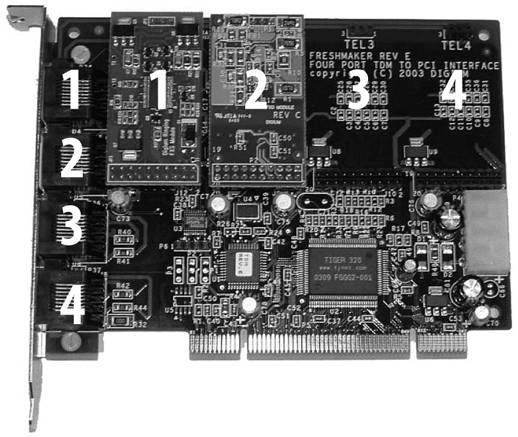Section 4.3. FXO and FXS Channels
The difference between an FXO channel and an FXS channel is simply which end of the connection provides the dial tone. An FXO port does not generate a dial tone; it accepts one. A common example is the dial tone provided by your phone company. An FXS port provides both the dial tone and ringing voltage to alert the station user of an inbound call. Both interfaces provide bidirectional communication (i.e., communication that is transmitted and received in both directions simultaneously ).
If your Asterisk server has a compatible FXO port, you can plug a telephone line from your telephone company (or "telco") into this port. Asterisk can then use the telco line to place and receive telephone calls. By that same token, if your Asterisk server has a compatible FXS port, you may plug an analog telephone into your Asterisk server, so that Asterisk may call the phone and you may place calls.
Ports are defined in the configuration by the signaling they use, as opposed to the physical type of port they are. For instance, a physical FXO port will be defined in configuration with FXS signaling, and an FXS port will be defined with FXO signaling. This can be confusing until you understand the reasons for it. FX_ cards are named not according to what they are, but rather according to what is connected to them. An FX S card, therefore, is a card that connects to a s tation. Since that is so, you can see that in order to do its job, an FXS card must behave like a central office and use FXO signaling. Similarly, an FX O card connects to a central o ffice (CO), which means it will need to behave like a station and use FXS signaling. The modem in your computer is a classic example of an FXO device.
|
4.3.1. Determining the FXO and FXS Ports on Your TDM400P
Figure 4-1 contains a picture of a TDM400P with an FXS module and an FXO module. You can't see the colors, but module 1 is a green FXS module and module 2 is an orange/red FXO module. In the bottom-right corner of the picture is the Molex connector, where power is supplied from computer's power supply.
|
Figure 4-1. A TDM400P with an FXS module (1 across) and an FXO module (2 across)

|
EAN: N/A
Pages: 380
